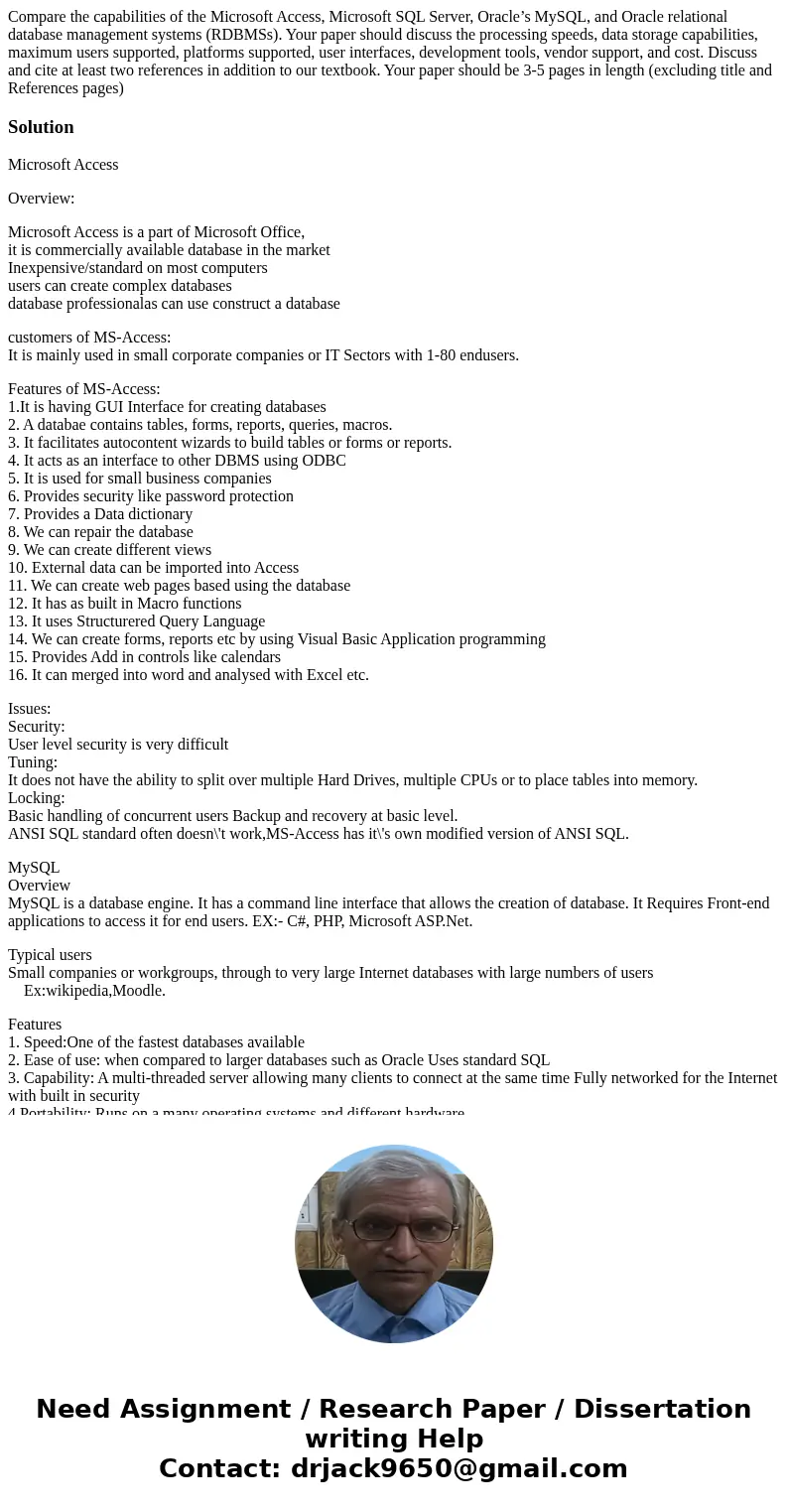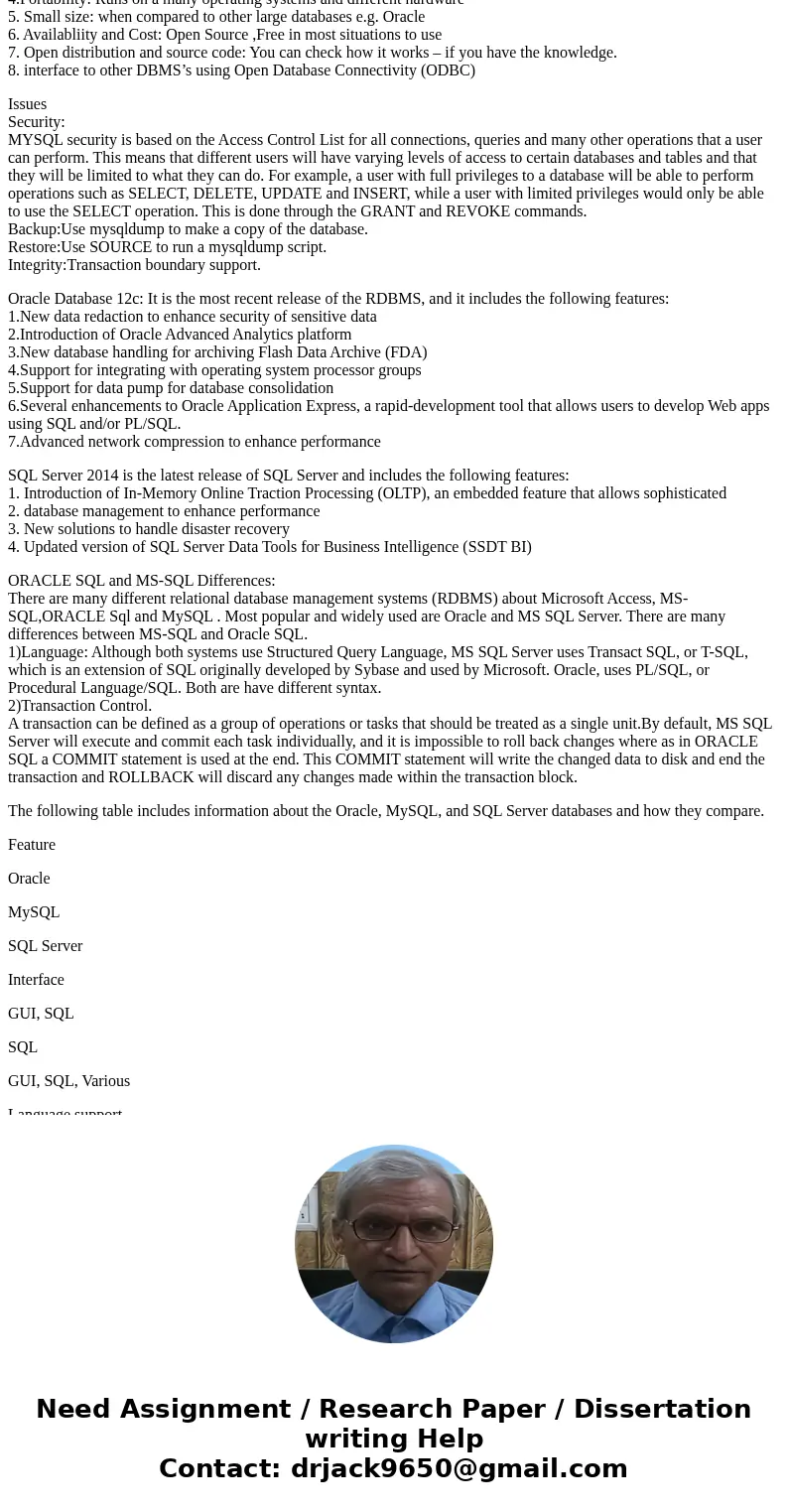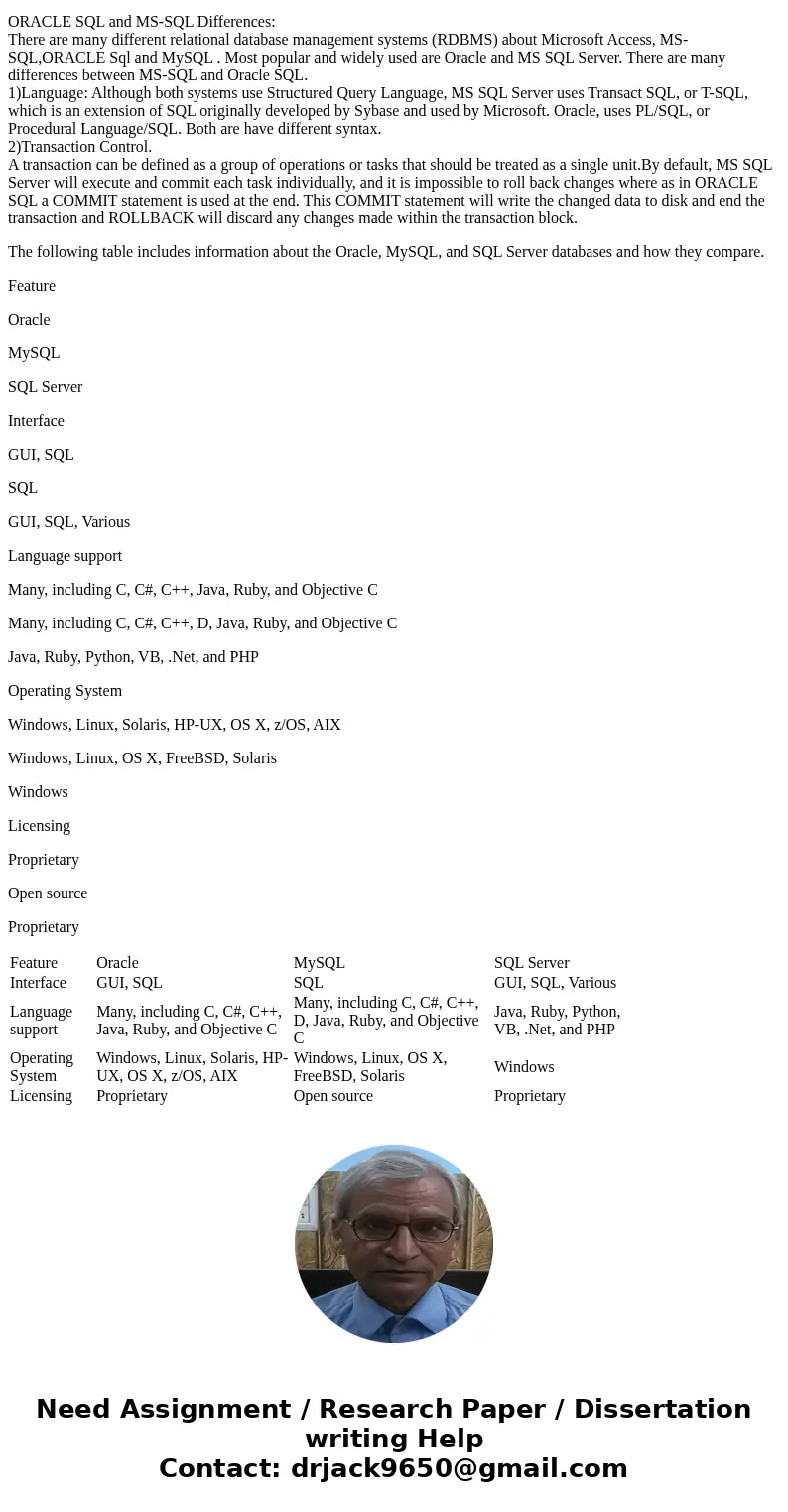Compare the capabilities of the Microsoft Access Microsoft S
Compare the capabilities of the Microsoft Access, Microsoft SQL Server, Oracle’s MySQL, and Oracle relational database management systems (RDBMSs). Your paper should discuss the processing speeds, data storage capabilities, maximum users supported, platforms supported, user interfaces, development tools, vendor support, and cost. Discuss and cite at least two references in addition to our textbook. Your paper should be 3-5 pages in length (excluding title and References pages)
Solution
Microsoft Access
Overview:
Microsoft Access is a part of Microsoft Office,
it is commercially available database in the market
Inexpensive/standard on most computers
users can create complex databases
database professionalas can use construct a database
customers of MS-Access:
It is mainly used in small corporate companies or IT Sectors with 1-80 endusers.
Features of MS-Access:
1.It is having GUI Interface for creating databases
2. A databae contains tables, forms, reports, queries, macros.
3. It facilitates autocontent wizards to build tables or forms or reports.
4. It acts as an interface to other DBMS using ODBC
5. It is used for small business companies
6. Provides security like password protection
7. Provides a Data dictionary
8. We can repair the database
9. We can create different views
10. External data can be imported into Access
11. We can create web pages based using the database
12. It has as built in Macro functions
13. It uses Structurered Query Language
14. We can create forms, reports etc by using Visual Basic Application programming
15. Provides Add in controls like calendars
16. It can merged into word and analysed with Excel etc.
Issues:
Security:
User level security is very difficult
Tuning:
It does not have the ability to split over multiple Hard Drives, multiple CPUs or to place tables into memory.
Locking:
Basic handling of concurrent users Backup and recovery at basic level.
ANSI SQL standard often doesn\'t work,MS-Access has it\'s own modified version of ANSI SQL.
MySQL
Overview
MySQL is a database engine. It has a command line interface that allows the creation of database. It Requires Front-end applications to access it for end users. EX:- C#, PHP, Microsoft ASP.Net.
Typical users
Small companies or workgroups, through to very large Internet databases with large numbers of users
Ex:wikipedia,Moodle.
Features
1. Speed:One of the fastest databases available
2. Ease of use: when compared to larger databases such as Oracle Uses standard SQL
3. Capability: A multi-threaded server allowing many clients to connect at the same time Fully networked for the Internet with built in security
4.Portability: Runs on a many operating systems and different hardware
5. Small size: when compared to other large databases e.g. Oracle
6. Availabliity and Cost: Open Source ,Free in most situations to use
7. Open distribution and source code: You can check how it works – if you have the knowledge.
8. interface to other DBMS’s using Open Database Connectivity (ODBC)
Issues
Security:
MYSQL security is based on the Access Control List for all connections, queries and many other operations that a user can perform. This means that different users will have varying levels of access to certain databases and tables and that they will be limited to what they can do. For example, a user with full privileges to a database will be able to perform operations such as SELECT, DELETE, UPDATE and INSERT, while a user with limited privileges would only be able to use the SELECT operation. This is done through the GRANT and REVOKE commands.
Backup:Use mysqldump to make a copy of the database.
Restore:Use SOURCE to run a mysqldump script.
Integrity:Transaction boundary support.
Oracle Database 12c: It is the most recent release of the RDBMS, and it includes the following features:
1.New data redaction to enhance security of sensitive data
2.Introduction of Oracle Advanced Analytics platform
3.New database handling for archiving Flash Data Archive (FDA)
4.Support for integrating with operating system processor groups
5.Support for data pump for database consolidation
6.Several enhancements to Oracle Application Express, a rapid-development tool that allows users to develop Web apps using SQL and/or PL/SQL.
7.Advanced network compression to enhance performance
SQL Server 2014 is the latest release of SQL Server and includes the following features:
1. Introduction of In-Memory Online Traction Processing (OLTP), an embedded feature that allows sophisticated
2. database management to enhance performance
3. New solutions to handle disaster recovery
4. Updated version of SQL Server Data Tools for Business Intelligence (SSDT BI)
ORACLE SQL and MS-SQL Differences:
There are many different relational database management systems (RDBMS) about Microsoft Access, MS-SQL,ORACLE Sql and MySQL . Most popular and widely used are Oracle and MS SQL Server. There are many differences between MS-SQL and Oracle SQL.
1)Language: Although both systems use Structured Query Language, MS SQL Server uses Transact SQL, or T-SQL, which is an extension of SQL originally developed by Sybase and used by Microsoft. Oracle, uses PL/SQL, or Procedural Language/SQL. Both are have different syntax.
2)Transaction Control.
A transaction can be defined as a group of operations or tasks that should be treated as a single unit.By default, MS SQL Server will execute and commit each task individually, and it is impossible to roll back changes where as in ORACLE SQL a COMMIT statement is used at the end. This COMMIT statement will write the changed data to disk and end the transaction and ROLLBACK will discard any changes made within the transaction block.
The following table includes information about the Oracle, MySQL, and SQL Server databases and how they compare.
Feature
Oracle
MySQL
SQL Server
Interface
GUI, SQL
SQL
GUI, SQL, Various
Language support
Many, including C, C#, C++, Java, Ruby, and Objective C
Many, including C, C#, C++, D, Java, Ruby, and Objective C
Java, Ruby, Python, VB, .Net, and PHP
Operating System
Windows, Linux, Solaris, HP-UX, OS X, z/OS, AIX
Windows, Linux, OS X, FreeBSD, Solaris
Windows
Licensing
Proprietary
Open source
Proprietary
| Feature | Oracle | MySQL | SQL Server |
| Interface | GUI, SQL | SQL | GUI, SQL, Various |
| Language support | Many, including C, C#, C++, Java, Ruby, and Objective C | Many, including C, C#, C++, D, Java, Ruby, and Objective C | Java, Ruby, Python, VB, .Net, and PHP |
| Operating System | Windows, Linux, Solaris, HP-UX, OS X, z/OS, AIX | Windows, Linux, OS X, FreeBSD, Solaris | Windows |
| Licensing | Proprietary | Open source | Proprietary |



 Homework Sourse
Homework Sourse